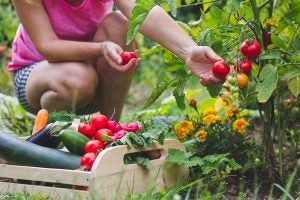Spring is finally upon us — tractors are getting ready to be out in the fields and stores have their garden accessories on display. Whether you are a full time farmer or just a beginning gardener, the discussion of applying fertilizers is an important one to have. That even applies for the areas set aside on your land for your own personal garden. The University of Minnesota Extension is hoping to help — they cover what kinds of fertilizer options are available and when to apply them.
We apply fertilizer to promote healthy plant growth including budding, flowers, fruit production and, in some cases, seed or nut production. Plants use a tremendous amount of energy to flower and produce fruit, seeds and nuts while continuing to develop a healthy root system and grow leaves for photosynthesis. Fertilizer helps plants to do all these things.
Too much fertilizer (applied too often or too much) can burn or desiccate roots, ultimately killing the plant. But, fertilizers do a lot of good by providing macro and micronutrients that enhance the health and performance of plants. Healthy plants will create a long-lived and attractive landscape. Check out a quick guide to fertilizing plants here.
Which fertilizer to choose?
Fertilizers of all kinds, from synthetic granular fertilizers to composted manures, have three numbers on the label written as # – # – #. These numbers stand for the percentage of nitrogen (N), phosphorus (P), and potassium (K) in the fertilizer. These are the three macronutrients that plants use in large concentrations as they grow.
The only way to know the proper balance of nitrogen, phosphorus, and potassium for your specific soil is through a soil test. While you do not need to do this every year, testing your soil every couple of years will help you to make sure you’re adding enough nutrients without overapplying others. Your soil test will provide you with a recommended balance of N, P, and K and the pounds needed for your gardening space. With that information, you can choose a fertilizer source that best matches your needs.
For a step-by-step guide on how to conduct a soil test, check out this video, or visit the UMN Soil Test Laboratory for written instructions.
Finally, understand the nutritional needs of your plant. Some plants like herbs grow fine in rather poor soil. Other plants like tomatoes need regular fertilizing to promote bloom, fruit set, etc. Fertilizers are also available that are specially designed for particular plants such as tomatoes, orchids, evergreens, and plants that require acidified soil such as Azaleas and blueberries. You can find more information on vegetables A-Z here.
Organic or synthetic?
Organic fertilizers take time to become available to plants. The nutrients in organic fertilizers are bound up in carbon, and so after being applied they slowly convert to usable nutrients the plant can take up through its roots.
Synthetic fertilizers are readily available to plants after being watered in, but they are more likely to burn plant roots if applied incorrectly.
If you have a plant that is demonstrating nitrogen deficiency (chlorosis — yellow leaf tissue between green leaf veins), it might be best to use a fertilizer that is quickly available (synthetic) to give the plant the needed nitrogen.
For your vegetable garden, you could use an organic fertilizer at the time of planting to give your plants a good head start and then apply it again later in the season when plants are actively producing fruit.
If you’re using compost, make sure the composting process is complete before adding it to your garden, or it may compete with your plants for nutrients as it breaks down. Compost that is “finished” should have a soil-like texture and should maintain a consistent temperature similar to ambient temperatures (it should not be hot).
Some synthetic fertilizers are also available as slow-release. These are pellets that dissolve slowly over time and slowly feed small amounts of fertilizer to the plant. They will not burn a plant, easy to apply, and great for containers. A good time to apply these fertilizers are at planting time and later in the summer.

When should I fertilize?
In general, fertilize plants when you start to see new growth – leaves, buds, roots, etc. – and when planting transplants.
- Don’t fertilize when plants are very dry or drought-stressed.
- Water the root area before fertilizing. The soil around the roots should be completely moist.
- If a plant is stressed by flooding, wait to fertilize until the excess water is absorbed or the fertilizer will simply run off.
- Don’t fertilize plants when they are dormant as it can encourage new growth at the wrong time of year.
You can find out more about managing soil and nutrients here.
How do I apply fertilizer?
For outdoor plants, follow the instructions for application. Avoid applying fertilizer on hard surfaces like sidewalks or on frozen ground as it will blow or run off into gutters and eventually pollute our waterways.
For houseplants, choose a fertilizer for your specific plant if available. Apply half the recommended strength when you see active growth and make sure the pot drains well to eliminate excess fertilizer. Flush plant soil with clean water every couple of months to avoid fertilizer build-up in the soil.


